Either you’re a first-time plant lover or a long-time green thumb gardener, finding the best fertilizers for your arborvitaes can be a daunting task.
Even if Arborvitaes have low fertilization requirements, extreme weather conditions, and changes in the soil temperatures also affect their plant health.
Arborvitae or Thuja is an evergreen tree that is native in the US. It’s a landscape-friendly tree that is used by most gardeners as a fence or to add some privacy to your property. It’s generally a low-maintenance plant that provides lush deep green foliage throughout the year.
It is recommended by most gardeners to fertilize arborvitaes once a year by choosing a slow-release fertilizer to gradually release the nutrients for an extended time.
The nutrients from the fertilizer will help these evergreen trees to grow faster with strong branches and green foliage.
In A Hurry, Our Top Picks:
In this post, we listed the 10 best fertilizers for arborvitae geared towards their long-term nourishment for the rest of the year.
Our top selection includes organic, chemical, and multipurpose fertilizers that will suit the preferences of any gardener.
So if you don’t know what fertilizer to choose, keep on reading and you might find what you’re looking for.
(You could use the table of contents below to jump to the sections that are most important to you.)
10 Best Fertilizers For Arborvitae – Product Reviews (2023)
While most of the products listed below have their respective pros and cons. If your arborvitae trees don’t show any signs of nutrient deficiency then it’s better not to use a fertilizer.
However, if they have yellowing leaves and not as green as before, you’ll need to give your arborvitae trees a boost with fertilizers.
Check out the best fertilizer for arborvitaes below and check what fits best on your plants:
1. Osmocote Smart-Release Plant Food
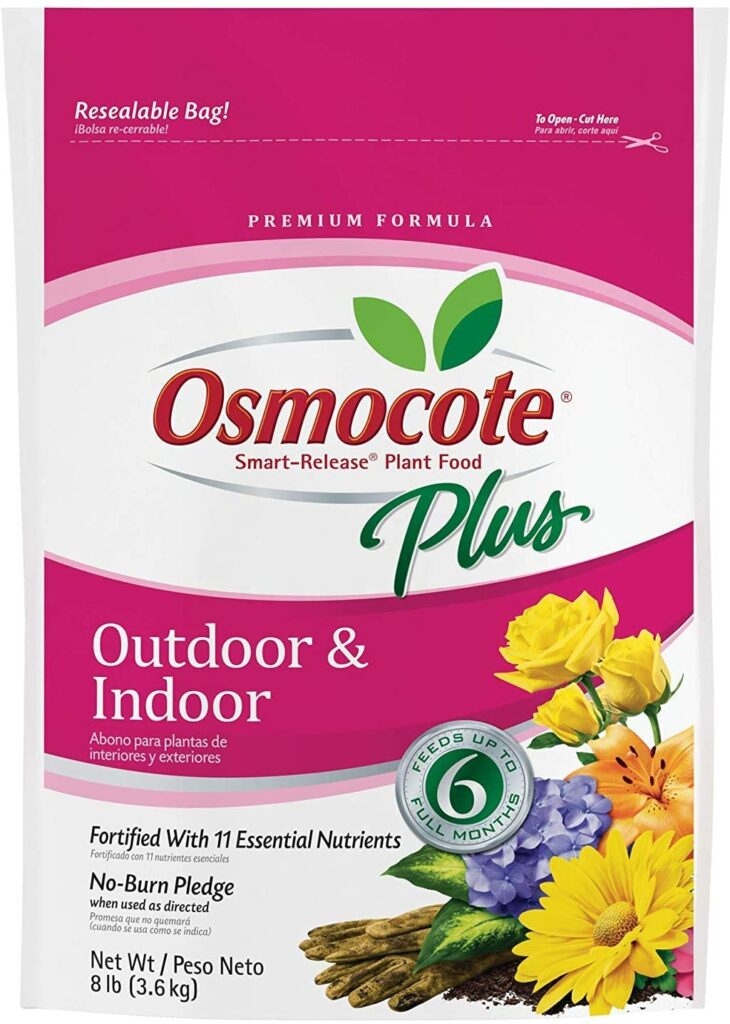
Oscomote is a natural slow-release fertilizer that will provide a continuous supply of nitrogen and other essential nutrients to promote the rapid growth of your arborvitae. It has 11 essential nutrients and minerals that will be gradually released into the soil within six months.
This fertilizer is a 9-6-12 NPK formula that will not burn your plants. It comes with resealable packaging so it’s more convenient and easy to use for future use. However, the release of the nutrients is highly dependent on soil and weather conditions.
This is also not a good option for organic gardeners as it contains non-organic materials.
So, make sure to keep it out of reach to children and pets. You should also use safety gloves in applying this fertilizer.
Pros
- A convenient slow-release formula that can last for 6 months
- Does not burn your plants
- Perfect for annual fertilization of arborvitae
- No odor
Cons
- Materials used are not organic
- Not kid and pet friendly
2. Schlutz Nursery Plus Slow-Release Plant Food
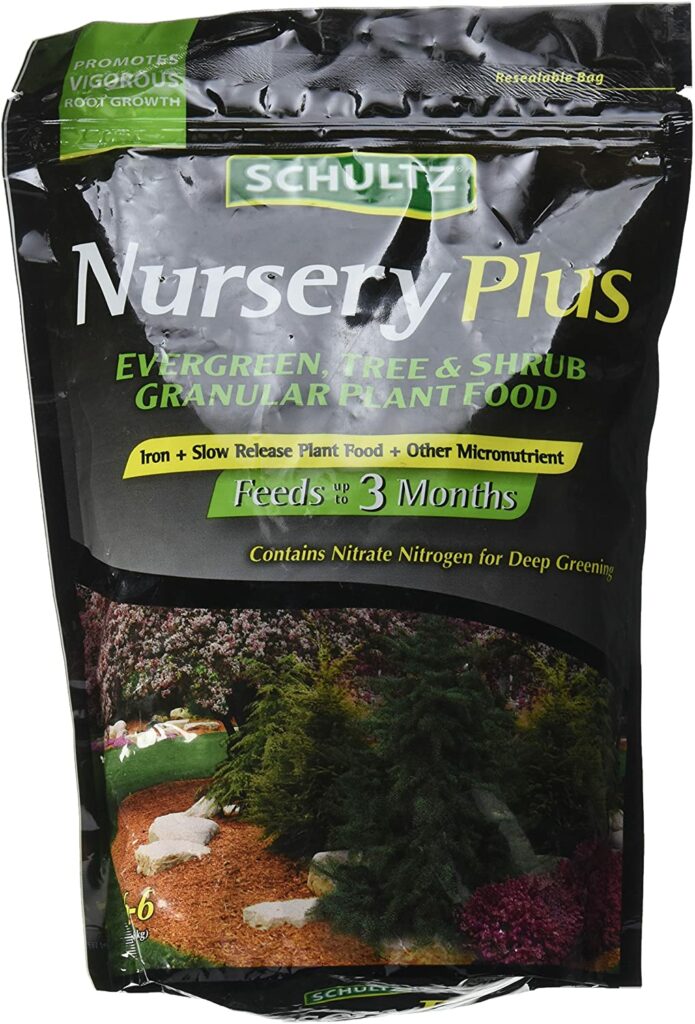
Schlutz Nursery Plus is a 12-6-6 NPK slow-release fertilizer. It is high in nitrogen content that promotes the rapid growth of arborvitae trees, strong root systems, and decreases their susceptibility to plant diseases. It also contains iron and other micronutrients that boost their green coloring.
This fertilizer can feed your arborvitaes, shrubs, and other evergreens for up to three months.
Schultz would suit the annual fertilization requirement of arborvitaes for an extended time. It also nourishes your evergreens with other nutrients such as boron, copper, iron, manganese, molybdenum, and zinc.
Compared to other slow-release fertilizers, the release of nutrients with Schlutz is triggered by soil temperature. It feeds your arborvitaes when the soil temperature goes up.
So, it works at its full potential during spring or the growing season of arborvitaes.
Pros
- High nitrogen content
- Feeds up to 3 months
- Packed with NPK, iron, and other micronutrients essential for leaf formation and green coloring
Cons
- Non-organic fertilizer
- Not kid and pet-friendly
- Release of nutrients is dependent on soil temperature that may not work as desired if the soil is not in its optimal condition.
3. Jobe’s Evergreen Fertilizer Spikes
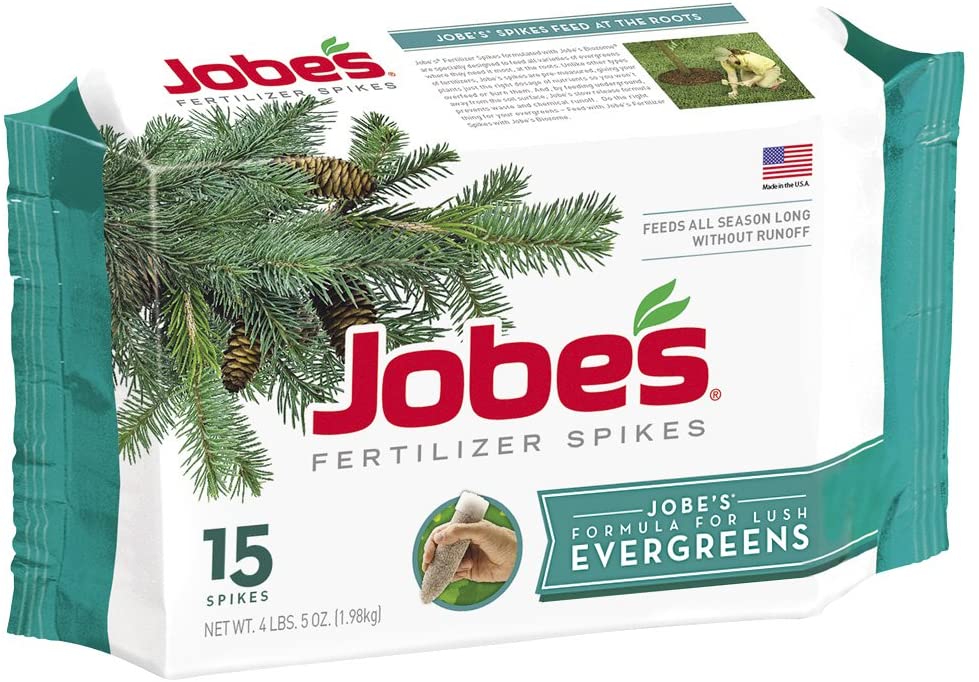
If you’ve been using granulated fertilizers for a while now, you might want to try using spikes for your arborvitaes this year.
Jobe’s Evergreen Fertilizer Tree Spike is a 13-3-4 NPK fertilizer that will take charge of feeding your arborvitaes for a maximum of 6 months.
Like other slow-release formulas, Jobe’s spikes provide a continuous supply of nutrients to your evergreens without wasting any fertilizer runoff. It’s also easy to apply and doesn’t need many materials to apply.
If the soil is too compact, it might break if you hammer it down to the soil, so other gardeners would dig a hole and insert the pikes.
Recommended application is by inserting the spikes at the dripline or 3 to 6 inches away from the trunk where the roots gather nutrients from the soil.
Jobe’s spikes have no lingering smell and are safe for kids and pets around your home.
Pros
- No smell
- Convenient application
- Ensures consistent feeding for up to 6 months
- Kid and pet friendly
Cons
- Non-organic fertilizer
- Applying the spikes in the wrong location may not feed your arborvitaes properly
- Broken down fertilizer spikes may no longer function as desired.
4. Down to Earth All Natural Tree & Shrub Fertilizer Mix
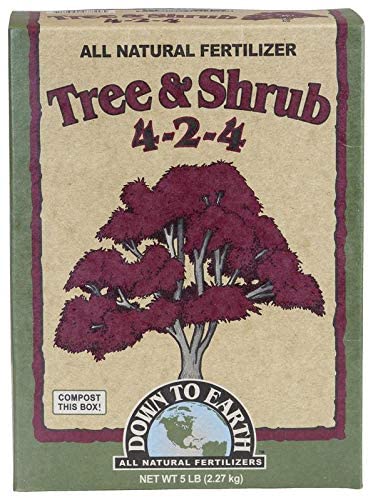
Down to Earth, All Natural Tree & Shrub Fertilizer is a 4-2-4 organic fertilizer that is a perfect option for organic arborvitae gardeners. It contains fish bone meal, corn gluten meal, langbeinite, greensand, humates, kelp meal, and 11 species of mycorrhizal fungi.
This fertilizer contains beneficial microbes that help improve the soil condition for the healthy growth of plants. Its mycorrhizal fungi content helps boost the root development of young arborvitaes and help decrease their susceptibility to plant diseases and stresses.
One of the benefits of this organic fertilizer is it helps strengthen arborvitae’s plant health against drought and extreme weather conditions that can affect its rapid growth.
Since it’s an organic fertilizer, it’s kid and pet-friendly.
Pros
- Organic fertilizer for evergreens
- Kid and pet-friendly
- Packed with NPK and other essential nutrients for arborvitaes rapid growth
Cons
- Bad smell due to its natural contents
- The smell may attract unwanted insects and animals to your yard
5. BioAdvanced Shrub Protect & Tree Food
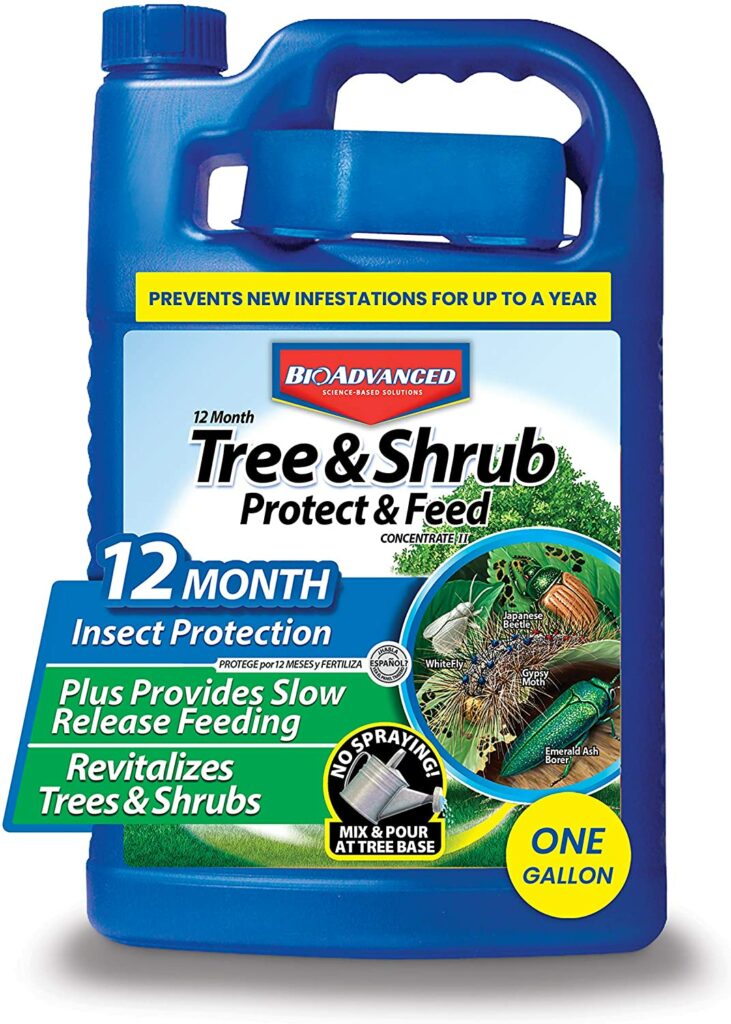
When it comes to practicality, some gardeners may prefer a multi-purpose fertilizer.
BioAdvanced Shrub Protect and Tree Food is one of the few brands in the market that serves as both fertilizer and insecticide.
This product is a 2-1-1 NPK synthetic fertilizer that protects your arborvitaes and other evergreens for the whole year. It has a slow-release formula that will help feed your plants for an extended period.
In terms of arborvitaes, then the added protection and gradual feed will work best for you.
As for the insecticide role of this fertilizer, It can help control the following pests:
- Emerald ash borers
- Aphids
- Caterpillars
The downside of this fertilizer that may concern some gardeners is it’s a systemic synthetic fertilizer and may damage your plants if used as a foliar spray.
Since it contains chemicals, this is not a kid and pet-friendly option, especially upon application or when the product has not dried up.
Pros
- Works as fertilizer and insecticide
- Slow-release formula feeds arborvitaes gradually for an extended time
- Contains beneficial microbes that help improve the soil condition
Cons
- Non-organic fertilizer
- Not for sale in New York and restricted in certain regions of the US like Connecticut, Vermont, and Maryland.
- Not pet and kid-friendly. May cause skin irritation and toxic to pets
6. Dr. Earth Organic And Natural Nitrogen All-Purpose Fertilizer
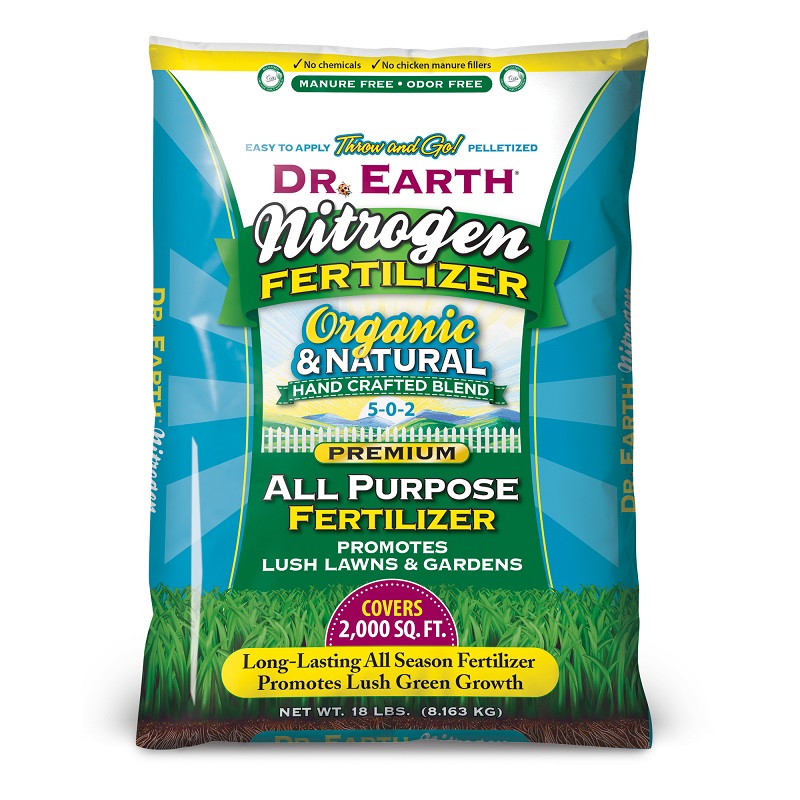
Next on our list is another organic fertilizer that most green thumbs are fond of. Dr. Earth has been hailed as one of the best organic fertilizers on the market due to its environment-friendly contents.
Arborvitaes are evergreen trees that benefit most from the abundant presence of nitrogen in the soil.
Evergreen trees have a distinct fondness for nitrogen and respond well to it than potassium and phosphorus.
So Dr. Earth’s Organic Nitrogen is a good way to accelerate the rapid growth of your arborvitaes.
This 5-0-2 NPK fertilizer is in a pelletized form that slowly releases nitrogen into the soil to be absorbed by the roots of your arborvitae trees.
The manufacturer prides itself on the fact that Dr. Earth’s line of fertilizers uses non-GMO infested manure and food-grade organic materials.
One bag of this fertilizer contains 18 lbs. that can cover 2000 sq. ft. It is a blend of fish bone meal, feather meal, green-based prebiotic ingredients, and mined potassium sulfate. It’s a kid and pet-friendly fertilizer and certified by OMRI.
Pros
- Organic fertilizer
- Used high-quality organic materials
- Environment-friendly
- Safe for kids and pets
- Consistently feed your arborvitaes throughout the season
Cons
- Bad smell due to its natural contents
- Not helpful for arborvitae deficient in other nutrients
7. Scotts Evergreen Flowering Tree & Shrub Continuous Release Plant Food
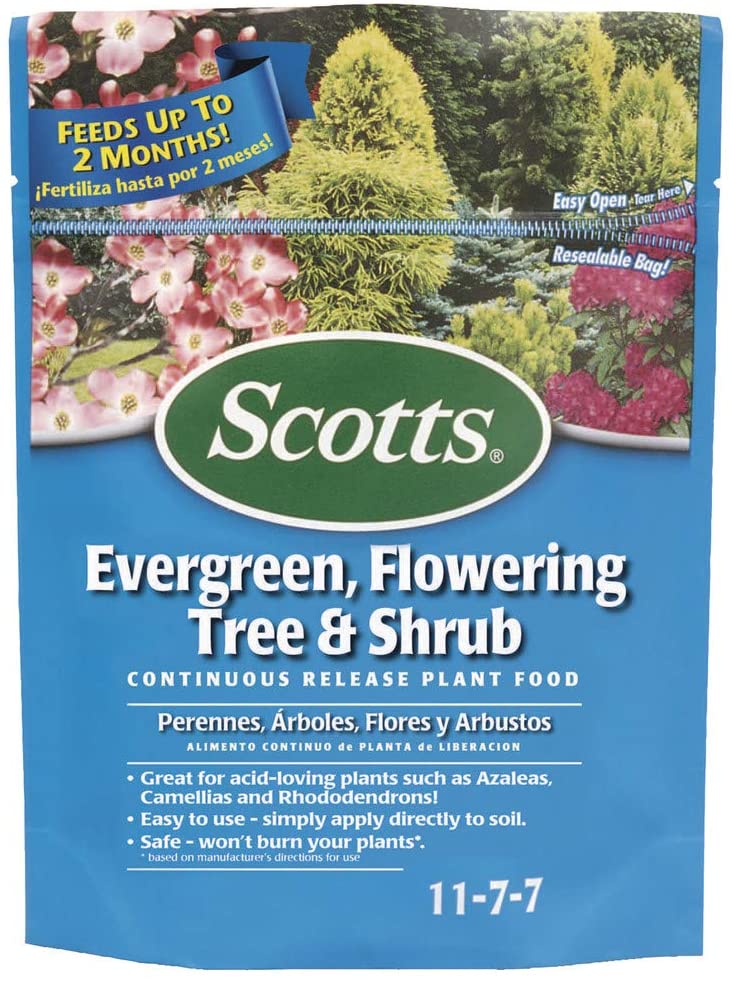
Scott’s Fertilizer for Evergreen Shrubs and Tree is another granulated slow-release fertilizer on our list that can feed your arborvitaes with nutrients with a higher nitrogen content and other essential nutrients.
This product is an 11-7-7 NPK that can feed your plants for up to two months. Since arborvitaes only need to be fertilized once a year, this product makes it a good option especially during the growing season in early spring.
Most gardeners find this product easy to use since you just have to mux the fertilizer on top of the soil and keep a good watering routine to nourish your trees.
Scott Evergreen’s fertilizer also claims that it won’t burn your plants as long as the proper application has been observed.
Pros
- Organic fertilizer
- Environment-friendly
- Easy to use
- If you are planting bulbs I recommend this for ease of use
Cons
- Strong smell
8. Espoma Plant-Tone
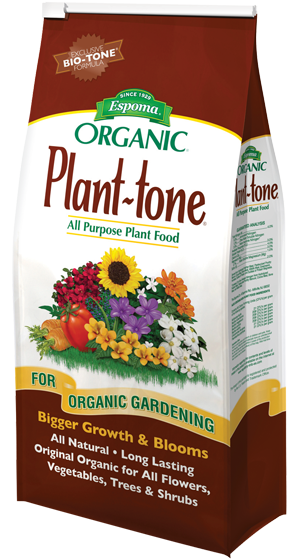
The third on our list as an organic contender is Espoma’s Plant-Tone. Though Espoma’s line of fertilizers has a specific formula for Evergreen plants, they recommend Plan-Tone since arborvitaes thrive better in a mildly acidic and mildly alkaline soil condition.
Plant-Tone contains Bio-Tone microbes that help feed the healthy microorganisms in the soil for the rapid growth of your plants. It can also be used for flowering plants, shrubs, and other evergreen plants.
So if you have a variety of plants in your yard, this would be an economical choice.
This product is a 5-3-3 NPK fertilizer. It’s organic and contains hydrolyzed feather meal, pasteurized poultry manure, bone meal, alfalfa meal, greensand, humates, sulfate of potash, and sulfate of potash Magnesia.
The formulation of Espoma’s Plant Tone is slow-release which helps prevent burning the roots of your arborvitaes and leaching the excess fertilizer to the groundwater. It also doesn’t contain any sludges, fillers, and toxic ingredients.
Therefore, it’s safe for you and your kids and pets.
Pros
- Organic fertilizer
- Environment-friendly
- Safe for kids and pets
- Contains Bio-tone microbes that help boost the rapid growth of arborvitaes
Cons
- Bad smell due to organic materials used
9. Vigoro Tree, Shrub, and Evergreen Plant Food
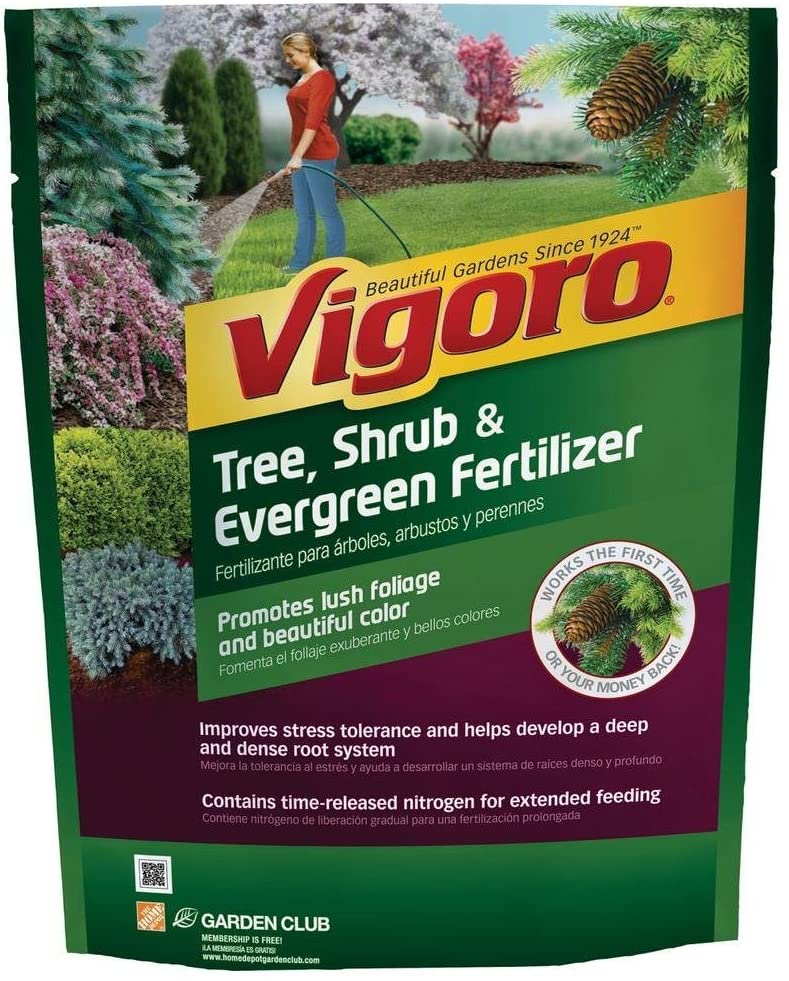
Arborvitae is an evergreen tree that will benefit a lot from fertilizers intended for its kind.
Vigoro evergreen fertilizer is a 16-4-8 NPK with a slow-release formulation in the form of pellets. It contains high nitrogen content that will help contribute to the rapid growth of evergreen trees like arborvitaes.
This fertilizer can feed your trees for up to 3 months. The formula of this fertilizer helps boost healthy root development, green foliage, and increases the plant’s stress tolerance.
Many gardeners appreciate this product for its cheap price while delivering good results.
Pros
- Improves the stress resistance of arborvitaes
- Can feed your plants for up to 3 months
- Reasonable price for a quality product
Cons
- Non-organic fertilizer
10. Ferti-Lome Azalea/Evergreen Food Plus
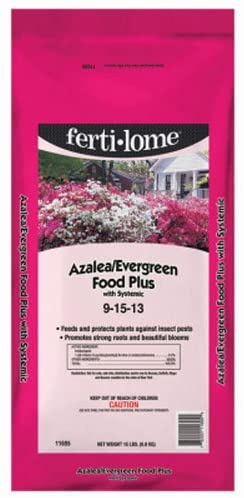
Another dual-purpose fertilizer on our list – Fertilome’s azalea/Evergreen Systemic Fertilizer.
It’s a 9-15-13 slow-release fertilizer that can feed your arborvitaes for up to two months. It also serves as a systemic insecticide that gas an active content of Imidacloprid.
Fertilome provides the essential nutrients absorbed by the tree through its roots and transmits the nutrients throughout the plant system. It also helps boost the root formation and lush foliage of evergreens during the growing season.
As an insecticide, it helps protect your plants against the following unwanted insects:
- Leaf beetles
- Psyllids
- Lace bugs
- Aphids
- Adelgids
- Japanese beetles
Pros
- Promotes strong roots & beautiful blooms
- Lasting Protection
- Plants respond after the first application
Cons
- Synthetic fertilizer
- Not pet and kid-friendly
What You Need To Know About Arborvitaes?
To make sure that you are doing the right steps in taking care of your arborvitaes, it’s worth checking its features and what are the optimal conditions that will make it healthier.
Here are some facts you need to know about these lush green trees:
(1) Arborvitaes are low-maintenance evergreen trees that thrive in full sun and partly shady environments.
(2) Unlike flowering plants, vegetables, and fruit trees, arborvitaes are not heavy-feeders and fertilizers only help them grow faster, maintain lush green foliage and be strong enough to resist changes in the environment and extreme weather conditions.
(3) It only needs to be fertilized once a year since too much feeding can do more harm than good to these evergreens. If it shows any deficiency it’s better to improve the soil condition by adding compost than re-apply fertilizer.
(4) Usually, what makes arborvitaes sick and unhealthy is the wrong watering routine. They should be watered daily in adequate amounts. Growing arborvitaes will require consistently moist soil since it’s not strong enough to withstand drought or dryness.
On the other hand, mature arborvitae trees will require less watering since they have already established the strength to withstand short periods of drought.
(5) The best time to fertilize arborvitaes is during early spring or late fall. It’s the growing season where they start root development and leaf and stem formation.
(6) Aside from the wrong watering routine, location also affects the plant health of arborvitaes. If your plants are closely planted to each other, they will be competing against each other for the nutrients in the ground that may cause certain deficiencies like the yellowing of leaves.
(7) Arborvitaes thrive in moist and well-drained soil and prefer loam soil. The soil should also be mildly acidic and mildly alkaline with soil PH ranging from 6.0 to 8.0.
(8) If your arborvitae trees don’t show any deficiencies, it’s okay to not apply fertilizer for the whole. It’s the reason why most gardeners find these trees very dependable and easy to grow.
However, they will need the help of fertilizers if they show signs such as:
- Slow growth
- Yellowing leaves
- Subtle green than dark green
(9) Arborvitaes will need less fertilizer as they mature. Usually, yearly feeding can only last during its growing stages that can span for the first five years.
(10) Arborvitaes need 6 hours of sunlight every day and can tolerate different climate conditions. They thrive in areas with high humidity.
(11) These evergreen trees can reach a height of 50 feet up to 60 feet.
How To Apply Fertilizer on Arborvitaes?
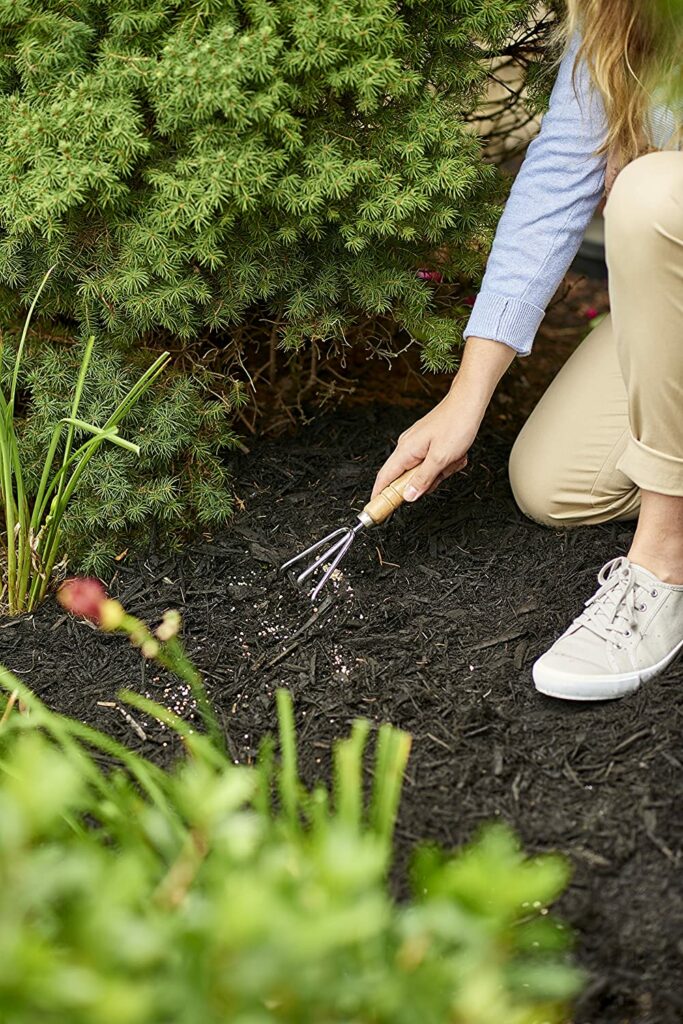
There are different types of fertilizers for arborvitaes and evergreens. Since they’re not heavy feeders, they mostly work well with slow-release fertilizers that come with pellets, granules, and spikes.
Regardless of the fertilizer type that you choose, here are the basic steps in applying fertilizers to arborvitae trees:
Pellets/Granules:
(1) Wear protective gloves and move aside the mulch or any debris on top of your arborvitae tree.
(2) Measure the amount of fertilizer you’ll need based on the product label. Use a cup to measure the granules or pellets.
(3) Apply the fertilizer around the trunk with a distance of 3 to 6 inches. Applying it too near to the trunk will burn the plant.
(4) Use a rake or hand rake to mix the first 1 to 2 inches of topsoil with the fertilizer. Do this lightly to avoid damaging the roots.
(5) Once the fertilizer has been well mixed with the topsoil, cover the area with mulch, and voila! Plant feeding is well taken care of!
Spikes:
(1) Check the product’s label and check how many spikes you need for your arborvitae. Usually, older trees will require more spikes.
(2) Once you identify how many spikes you’ll need, wear a pair of protective gloves to protect your skin from harmful chemicals in the fertilizer.
(3) Find a good location around your arborvitae and check the soil. If it’s too compact and hard, you should opt to dig a hole to avoid breaking the spike. Otherwise, you can hammer the spike down.
(4) You should apply the spike at the dripline of the tree which is around 10 to 12 inches away from the trunk.
Note: The distance depends on the size of the trunk.
(5) If the soil is loose enough to hammer the spike down. Cover the spike with the cap that comes with the product. It will serve as the barrier to help you hammer the spike into the soil without breaking it.
(6) Once done, cover it again with soil and mulch. As you water your tres the spike will release the nutrients for your arborvitaes.
Tips in Applying Fertilizers on Arborvitaes
While applying fertilizers is pretty straightforward, it can make or break your plants.
First-time gardeners may miss some of the crucial timing and details in fertilizing arborvitaes that can kill their plants.
So, here are some tips before you feed your plants:
- Do not fertilize newly planted arborvitae trees. The roots of young arborvitae trees are not yet developed to handle fertilizers. If you want to nourish the plant, you should opt for improving the soil condition by adding compost or manure.
- It only takes one fertilization per year to keep your arborvitaes healthy. If you notice that they look unhealthy, you should observe your watering schedules. It’s either they are overwatered or underwatered.
- The soil around the trunk should be well-draining before you apply the fertilizer. Otherwise, your arborvitae will burn because of too much concentration of chemicals.
- You should keep the granules or pellets away from the trunk to avoid burning the plant. Roots grow away from the trunk underground so you may want to apply it to that area(dripline) to ensure the fertilizer is absorbed properly by your arborvitae.
- Use a moisture or PH meter to know what fertilizer to use since arborvitaes prefer mildly acidic and mildly alkaline soil.
- Don’t feed your arborvitaes a month before the first frost to allow them to prepare for dormancy.
Frequently Asked Questions (FAQs)
When should I fertilize my emerald Arborvitae?
You should start fertilizing your emerald arborvitaes during Spring starting in March to allow them to develop a strong root system.
Preferably, you should opt to use a slow-release fertilizer for a more convenient way of feeding your arborvitaes.
How can I make my Arborvitae grow faster?
To promote the rapid growth of arborvitaes, you should plant them at a good distance from other plants so they will not compete for nutrients in the soil.
You should also observe a proper watering schedule ensuring that the soil is moist during its growing season. Support its growth by applying a fertilizer every year.
Is Holly Tone good for Arborvitae?
Holly-Tone does mention evergreens in their product label. However, they also mentioned that the formula of the fertilizer works best for acid-loving plants.
As mentioned by the manufacturer on their website, you should opt for the Plant Tone since arborvitaes and Boxwood are not acid-loving evergreens.
Are coffee grounds good for Arborvitae?
Coffee grounds are acidic and if your arborvitaes lack acidity then applying coffee grounds may work for you. To know the acidity level of the soil you may use a PH meter before you add anything to the soil.
Why is my newly planted Arborvitae turning brown?
Newly transplanted plants receive a great shock due to the roots they have lost during the transfer and the new soil environment they’re in.
Give them enough time to recuperate and adjust to their new location while adding natural sources of nutrients like manure and compost.
Will Arborvitae fill-in?
Arborvitaes are one of the dependable evergreens. They can always grow back during the growing season or Spring.
Just give them some time to regenerate cells and energy. You may not see any movement externally but the tree will one day show new leaves. All you have to do is be patient.
How do you fix brown Arborvitae?
The leaves may have turned brown due to extreme weather conditions.
However, the arborvitae’s system may try to regain its energy and turn the brown leaves back to green in no time. Give it a chance to work its way in healing itself until Spring before you prune them.
Can you save dying Arborvitae?
Unless there are green leaves left, the dead branches can no longer be saved. Arborvitaes may be dependable but there are certain cases that they can’t be revived anymore.
If there are still green leaves hanging on the branches, there might still be some hope so post-pone pruning them out and see if the tree will survive until the next Spring.
Final Thoughts
We hope that this article has helped you find the best fertilizer for your arborvitaes.
While arborvitaes are strong, dependable, and versatile, giving them a yearly treat to sustain certain deficiencies will pay you off with a lush green set of trees in your yard.
If you find this article helpful in finding the fertilizers that work wonders on your arborvitaes, let us know in the comments and share your experience with us. May you enjoy the view of your lush green arborvitaes and see the fruits of your tender-loving care for them.
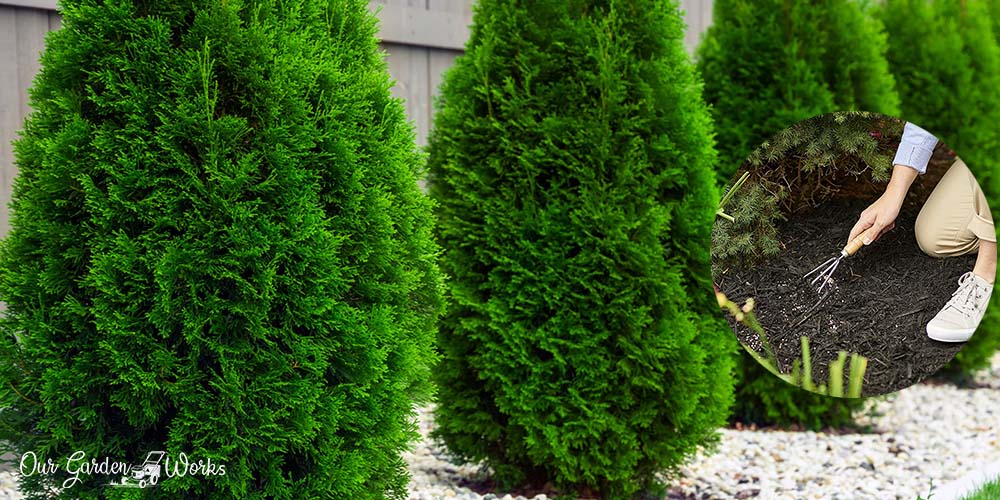
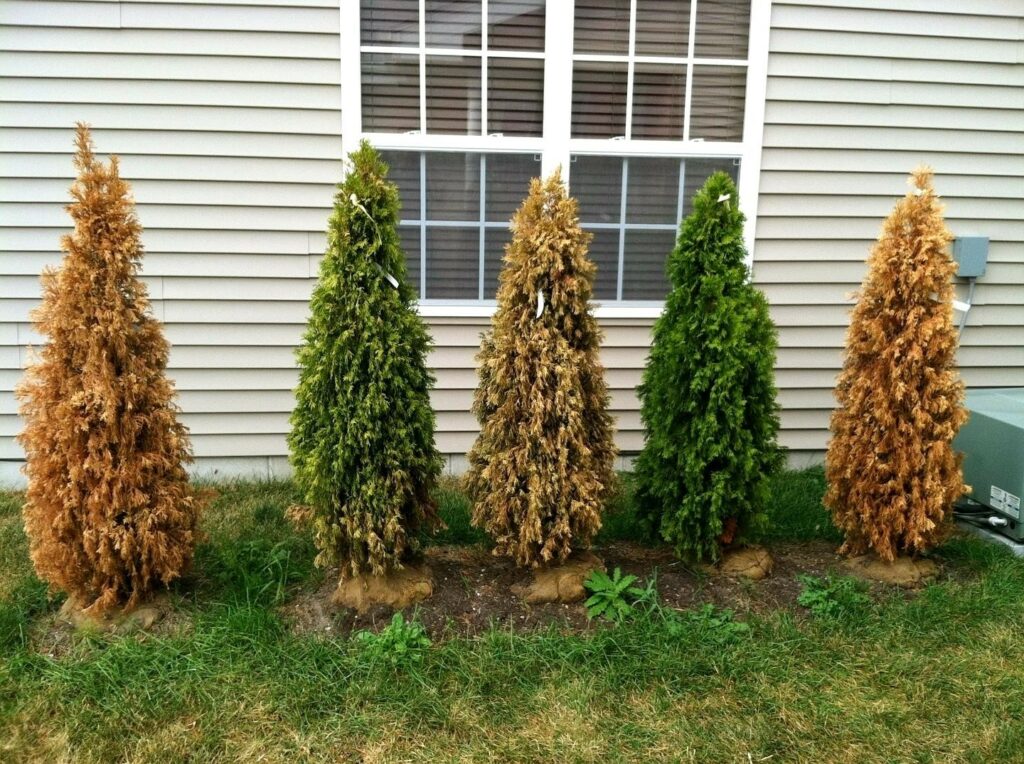
Great list with a detailed review of each product. Thanks for creating this list and providing all the important information about the best fertilizers.
On Jobes packaging it states “Never insert spikes closer than 30 inches from the tree trunk” (13-3-4). Your article states to insert 3-6 inches from trunk. Which is safest? My evergreens average about 6-10 feet high. Thank you
Hi Tammy,
Hi! The drip line is where branches end. The 3 to 6-inch distance from the stem is a rough estimate on where the branches of your arborvitaes end. If you place the spikes too far from the drip line the roots will not absorb the nutrients. The safest distance is the spot parallel to the end of the branches. Happy gardening!
Kind regards from Jeanne K.